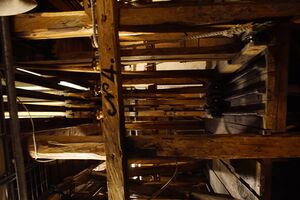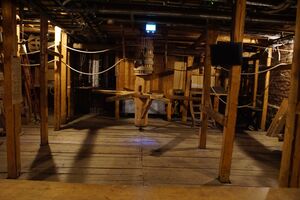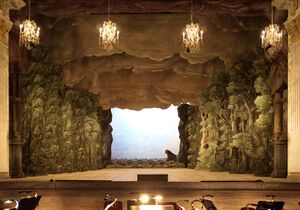The Transforming Stage
Synchronised scene changes
Baroque court theatres used elaborate, hidden machinery under and above the stage to create scene changes to be marvelled at. In moments, one painted perspective scene would be replaced by another, apparently without human intervention.
From the early 18th century, court theatres began to appear in Europe. They had in common wooden machinery that enabled synchronised scene changes of both the painted scenic flats at the side of the stage (the ‘wing flats’) and those overhead (‘headers’). The flats depicting one scene moved off the stage, and – simultaneously – another set of flats depicting a second scene moved onto the stage. The technical solution varied from one theatre to another, but all of them were able to operate these scene changes from only one or two places in the stage cellar, using ropes and pulleys to connect the moving scenery to one or more capstan shafts driven by a group of stagehands under the stage.
The Drottningholm Court Theatre outside Stockholm in Sweden (Q34) still has its fully functional stage machinery, where the wing flats on each side of the stage, as well as the headers over the stage, can be moved in the same operation. The scenography of the court theatres was based entirely on a central perspective, organised to give the ideal view to the prince or monarch, with wing flats and headers placed parallel to the front of the stage, forming a series of portals diminishing in size towards the rear of the stage, so creating the perspective effect (F.03).
The painted wing flats were attached to frames on either side of the stage. These frames in turn extended through slits in the floor, down to the stage cellar where they attached to the ‘chariots’, which could roll from side to side on a wooden track (Q19398). The movement of the frames was such that when they were on the off-stage position, furthest from the centre of the stage, the attached wing flat was hidden, but when the frame was moved on-stage, into the centre, the wing flat appeared in view. The frames with their chariots were in groups, and between these groups there were larger gaps to allow for entrances for the actors. At the front of the stage there could be up to four frames directly behind one another, while at the back of the stage there were only two frames grouped together.
Typically, the under-stage machinery was in the form of a centrally mounted shaft extending from the front of the stage cellar to the back. To this central shaft were attached ropes, directly or indirectly via pulleys, to each of the chariots. When the shaft was turned, the ropes began to be wound up onto the shaft, moving the attached chariots with their frames and scenic flats. Chariots attached directly to the shaft were pulled in towards the centre of the stage, so appearing into view, while those whose rope was attached via a pulley at the side of the cellar space were pulled in the opposite direction, away from the stage centre and so out of view.
Similarly, the scenic headers, arranged in pairs, were suspended on ropes so they could be lowered and raised into and out of view. In the loft over the stage there was a shaft that ran from the front of the stage to the back. The ropes that supported the headers were attached to the shaft so that when it rotated, one of the pair was lowered while the other was raised. Both the machinery in the cellar and in the loft were moved by capstans, hand-powered by up to six people per capstan. In some theatres, including Drottningholm, the ropes operating the chariots were diverted via pulleys to the capstan, rather than running them directly between the shaft and the chariot. In this way, both a large and centrally located trapdoor, as well as two smaller ones further back on the stage could be accommodated, without being blocked by a drive shaft.
The final part of the stage picture was the backdrop, closing off the view upstage. In some theatres, there was enough height above the stage for the cloths to be raised out of view with a counterweight system. Where there was less height, the cloth would be raised in two parts, lifted first from the top of the cloth, and then from a point two-thirds of the way down, so the cloth folded as it rose and occupied a space only one third of its actual height.
When all the machinery was operated together, one complete scene comprising painted wing flats, headers and backdrop was replaced by another: the location moved from palace interior to garden, to forest, to seascape in a few moments, with the mechanism entirely concealed. The idea of transformation was central to the performances of the Baroque court theatres. As well as offering the audience delight and amazement, it – like the geometric gardens outside the palace – demonstrated an orderly world, operated by clockwork-like mechanisms, all under the benign eye of the powerful yet benevolent monarch.


